LTE ETWS
This tutorial shows how to test LTE ETWS on Amari Callbox with a commercial phone. ETWS stands for Earthquake and Tsunami Warning System. It is a type of PWS (Public Warning System). Basic RAN Process of LTE ETWS is as follows :
- Transmit SIB10 with ETWS Message Info (Message ID, Serial Number, Warning Type)
- Transmit SIB11 with ETWS Message Contents
- Transmit Paging to inform UE to decode the ETWS
In real deployment, this process is controlled by ETWS server in core network side. It is the ETWS server and Core Network which are triggering the whole ETWS process and RAN to transmit the message.
Table of Contents
Introduction
The Earthquake and Tsunami Warning System (ETWS) is a critical component of the Public Warning System (PWS) architecture standardized in LTE networks, designed to rapidly disseminate emergency alerts such as earthquake and tsunami warnings to mobile devices within affected regions. Leveraging the robust broadcast capabilities of LTE radio access networks (RAN), ETWS enables the delivery of time-sensitive, high-priority notifications to all compatible user equipment (UEs), ensuring maximal reach and minimal delay. The system operates through a coordinated process: the core network's ETWS server initiates the warning cascade, orchestrating message creation, scheduling, and transmission commands to the RAN. The eNodeB (LTE base station) then conveys the ETWS notifications via System Information Blocks (SIB10 and SIB11) over broadcast channels, and triggers paging procedures to prompt UEs to immediately decode the incoming alert. Unlike legacy 2G/3G broadcast solutions, which utilized dedicated channels such as CTCH over FACH-SCCPCH, LTE's PWS repurposes existing broadcast channels (typically BCCH mapped onto PDSCH) for efficient, streamlined operation. This architecture not only enhances network resource utilization but also ensures compatibility with commercial LTE devices. In this context, the Amari Callbox system from Amarisoft offers a testbed environment for validating ETWS broadcast behavior and UE response using commercial off-the-shelf phones. Understanding the interplay between core network signaling, RAN message broadcasting, and UE decoding mechanisms is essential for telecom engineers, network testers, and emergency communication solution developers seeking to ensure compliance, reliability, and effectiveness of ETWS in real-world deployments.
-
Technology Context and Background
- ETWS is part of the broader LTE PWS framework, enabling mass delivery of emergency alerts using standardized procedures and interfaces.
- The system leverages core network components (e.g., ETWS server, MME) to trigger and manage alerts, while the RAN (eNodeB) broadcasts messages to all UEs in the coverage area.
- SIB10 provides ETWS message metadata (such as message ID, serial number, and warning type), while SIB11 carries the actual warning content.
- The paging procedure ensures that UEs promptly decode the ETWS message upon reception.
- Unlike 2G/3G CBS implementations, LTE PWS uses existing broadcast channels, improving spectrum efficiency and reducing implementation complexity.
- Amarisoft’s Amari Callbox provides a controlled environment for simulating and testing LTE ETWS procedures with commercial devices.
-
Relevance and Importance of the Tutorial
- Demonstrates practical ETWS testing on Amari Callbox, equipping professionals with hands-on experience in LTE emergency broadcast systems.
- Facilitates understanding of critical LTE PWS procedures, contributing to the reliability and compliance of public warning deployments.
- Provides insights into differences between LTE PWS and legacy CBS mechanisms, highlighting architectural evolution.
- Supports validation of commercial device compatibility and behavior in response to ETWS alerts.
-
Learning Outcomes
- Gain a comprehensive understanding of LTE ETWS architecture and broadcast mechanisms.
- Learn to configure and operate Amari Callbox for ETWS message transmission and UE testing.
- Acquire the ability to analyze and interpret UE behavior in response to ETWS paging and broadcast messages.
- Develop awareness of standards compliance and best practices for public warning systems in LTE networks.
-
Prerequisite Knowledge and Skills
- Familiarity with LTE network architecture, including the roles of eNodeB, MME, and broadcast channels.
- Basic understanding of System Information Blocks (SIBs) and paging procedures in LTE.
- Experience with test equipment such as Amari Callbox and commercial LTE handsets.
- General knowledge of public warning systems and emergency communication protocols is beneficial.
Summary of the Tutorial
This tutorial provides a step-by-step procedure to test the LTE ETWS (Earthquake and Tsunami Warning System) / CMAS (Commercial Mobile Alert System) broadcast functionality using a callbox and UE setup. The summary below details the test methodologies and procedures as described in the tutorial.
- Test Setup
- Use a SIM card delivered with the system.
- For configuration changes, refer to the Configuration Guide.
- Key Configuration Parameters
- Important parameters for ETWS/CMAS broadcast are set in the pws_msgs section of the MME configuration file.
- Parameters include: local_identifier, message_identifier, serial_number, data_coding_scheme, repetition_period, warning_type, warning_message, warning_message_hex, send_warning_indication, and warning_area_list.
- Configuration
- Use the default LTE eNB configuration file (enb.default.cfg); no special configuration required for ETWS at the eNB.
- Modify mme-ims-etws.cfg to add ETWS-specific pws_msgs configuration. This determines the content of the broadcast message.
- Test Procedure
- Start LTE service and verify cell configuration. Any LTE cell configuration is suitable.
- Power on the UE and allow it to attach to the LTE cell.
- Verify that the UE is successfully attached to the MME.
- Send a CMAS/ETWS message using the pws_write command, specifying the correct local_identifier as configured in pws_msgs.
- Check on the UE for reception of the ETWS/CMAS message:
- Verify both the display of the text message and the sounding of the alarm on the UE. Both are required for a successful test.
- To stop the ETWS message, use the corresponding stop command, again referencing the local_identifier.
- Log Analysis
- Enable logging for BCCH and RRC to capture ETWS broadcast activity.
- Adjust log viewer layers for easier analysis.
- Observe that, upon sending the ETWS message from the core, the eNB broadcasts the ETWS message and sends a Paging message with etws-indication.
- ETWS content is broadcast via SIB10 and SIB11 messages, populated from the pws_msgs configuration.
- To modify the broadcast content for testing, adjust the pws_msgs section in the configuration file.
Throughout the process, the methodology centers on configuring the network to generate ETWS/CMAS alerts, verifying their transmission and reception, and confirming proper behavior on the UE, accompanied by log analysis to validate message flow and content broadcast via SIBs and Paging.
Test Setup
Test setup for this tutorial is as shown below.
- SIM Card used in this tutorial is the one delivered with the system as it is.
- If you want to change the configuration, The tutorial Configuration Guide would help
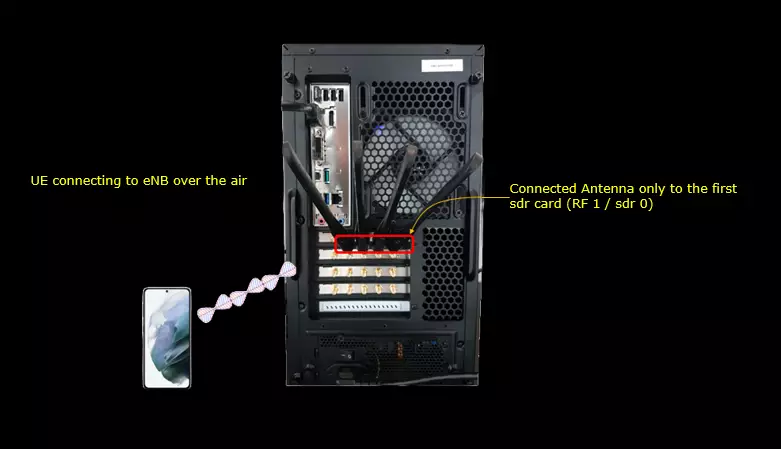
Key Configuration Parameters
Followings are important configuration parameters for this tutorial. You may click on the items for the descriptions from Amarisoft documents.
- pws_msgs : In this link, you would get the descriptions for all the items listed below. In the document, there are much more parameters (optional parameters) than the list below
- local_identifier
- message_identifier
- serial_number
- data_coding_scheme
- repetition_period
- warning_type
- warning_message
- warning_message_hex
- send_warning_indication
- warning_area_list
Configuration
I used the enb.default.cfg (LTE default configuration) as it is without changing any contents in it. Basically you can use any kind of enb configuration. eNB does not require any specific configuration for ETWS.

I also used mme-ims-etws.cfg which was copied and modified from mme-ims.cfg.

In mme-ims-etws.cfg .I have added the following configuration. pws_msgs is the parameter where you can configure the details of ETWS.

Perform the test
Start LTE service and check basic cell configuration. Any cell configuration is OK as long as it is LTE cell.

Power on UE and let UE attach to the cell

Confirm that UE is attached to mmel

Send CMAS using pws_write command as shown below. (

Check if you get CMAS message as shown below. You should hear alarm sound from the UE as well. Both text message and Alarm sound is requirement for the test.
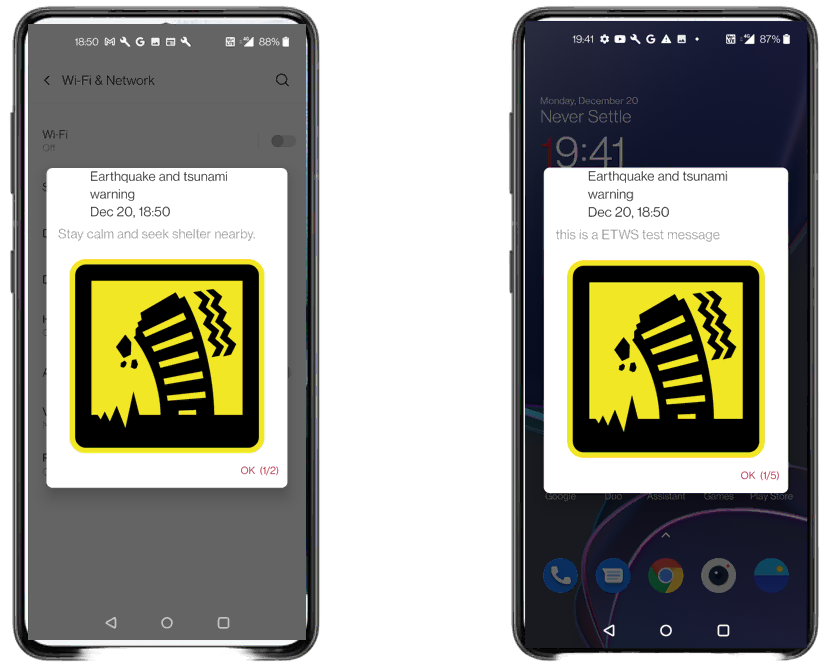
You can stop etws message using the following command. (

Log Analysis
Since ETWS message is broadcast by SIB message, the first step for ETWS log analysis is to capture the log with BCCH and RRC enabled as shown below.

Set the layer as shown below for the convinience of the log analysis.

When you send the ETWS message message, Core Network send ETWS message as shown below.|

When Core Network send ETWS, eNB send Paging with etws-indication
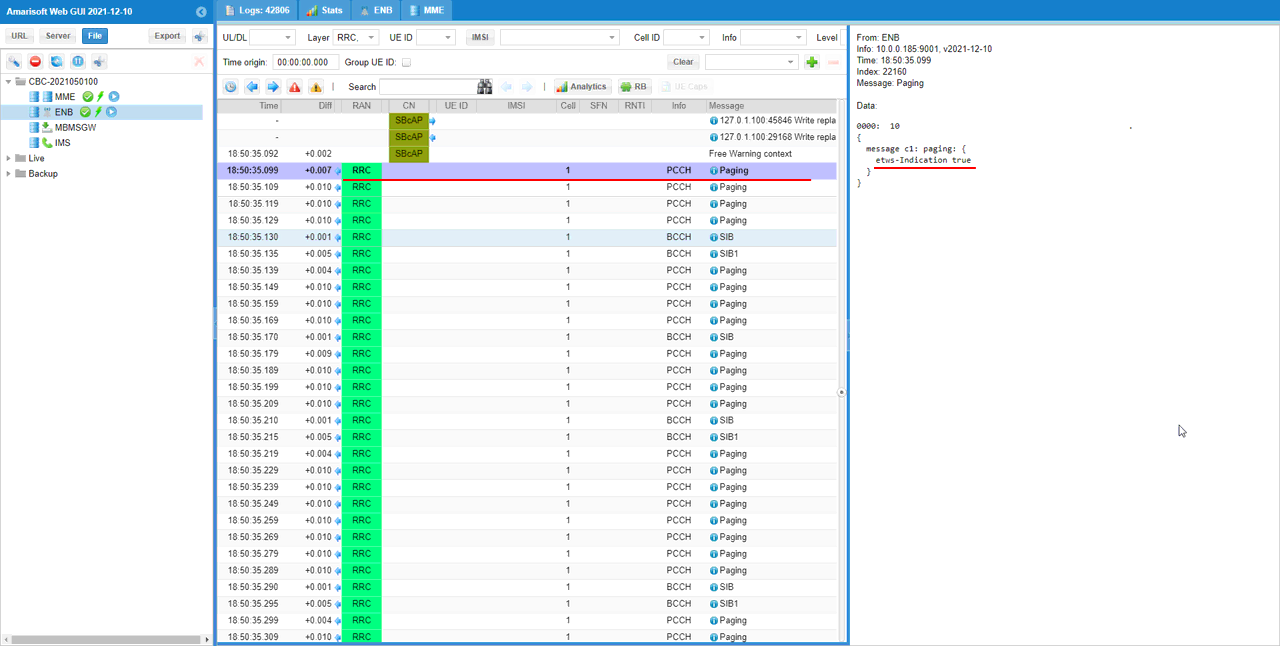
ETWS message is broadcast via sib10 and sib11. These messages are carrying all the contents configured by pws_msgs parameter in the configuration file. If you want to modify any part of sib10 and 11 for testing purpose, you should change the configuration of pws_msgs parameter in the configuration file.
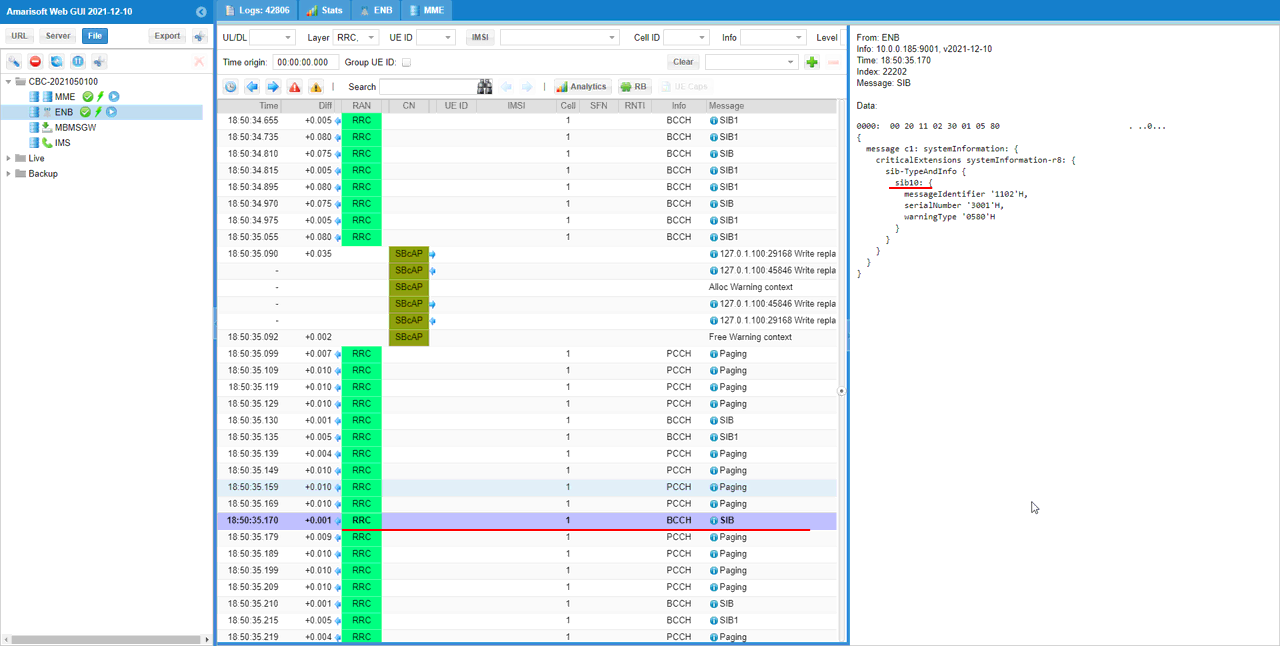
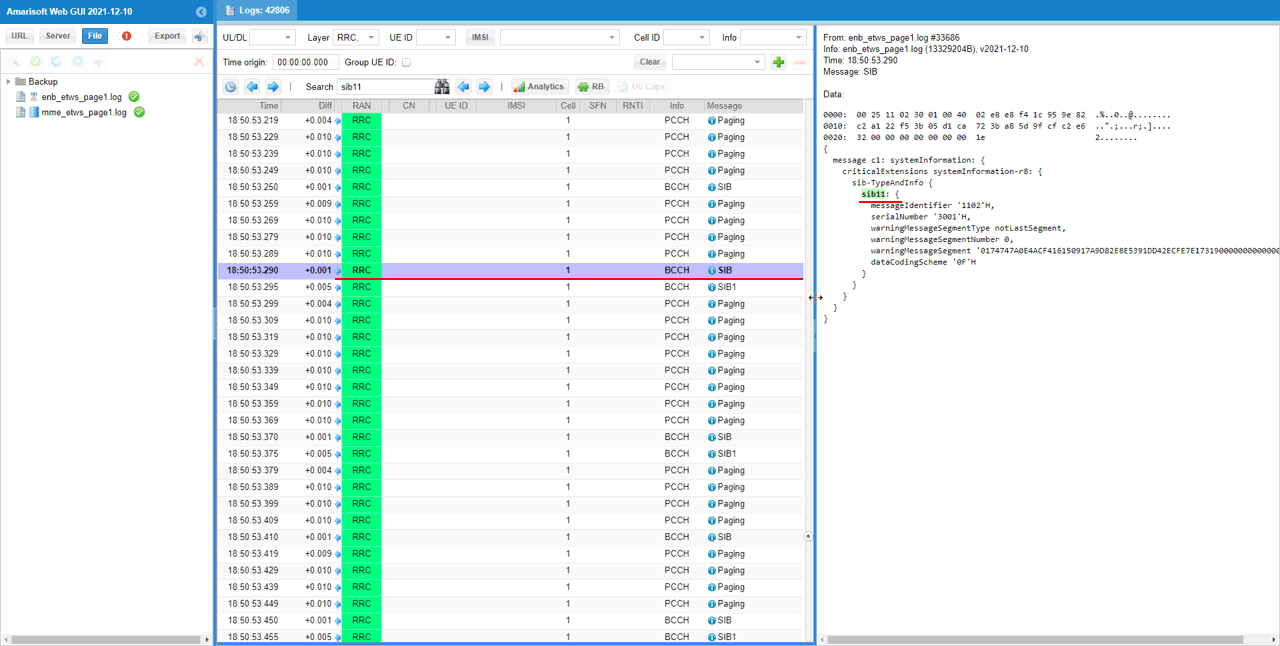
RRC / NAS Signaling
SIB 10
: This is the SIB 10 message sent by eNB to configure ETWS. (
{
message c1: systemInformation: {
criticalExtensions systemInformation-r8: {
sib-TypeAndInfo {
sib10: {
messageIdentifier '1102'H,
serialNumber '3001'H,
warningType '0580'H
}
}
}
}
}
SIB 11
: This is the SIB 11 message sent by eNB to configure ETWS. (
{
message c1: systemInformation: {
criticalExtensions systemInformation-r8: {
sib-TypeAndInfo {
sib11: {
messageIdentifier '1102'H,
serialNumber '3001'H,
warningMessageSegmentType notLastSegment,
warningMessageSegmentNumber 0,
warningMessageSegment '0174747A0E4ACF416150917A9D82E8E5391DD42ECFE7E1731900000000000000'H,
dataCodingScheme '0F'H
}
}
}
}
}
Paging
: This is the Paging message sent by eNB to Notify that ETWS is transmitted. (
{
message c1: paging: {
etws-Indication true
}
}